|
|
Hunter's Moon

|
|
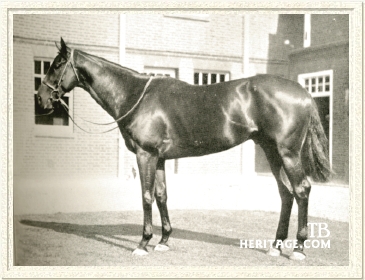 |
|
|
Although Hunter's Moon was one of the lesser of the numerous stakes winners and stallions from the mare Selene, he became a leading sire and profound influence in his adopted Argentina and Brazil.
Bred and owned by Lord Derby, the 17th Earl of Derby, whose father had founded the Stanley House Studs in the late 1800s, Hunter's Moon was the third foal out of Derby's prized broodmare Selene (by Chaucer - Serenissima by Minoru). Selene's previous foals were Sickle and Pharamond II, both sons of the speedy home sire, the speedy Phalaris. Like their sire, they both lacked classic stamina but this wouldn't have been known at the time of Selene's trip to Lavington Stud to visit the stayer Hurry On in 1925. More likely, because the mare's first two foals were on the small side like their dam, the 17 hand, ruggedly handsome Hurry On was probably chosen to add some size to the mix. Being a stayer and a sire of stayers, Hurry On was also a very different racing type from Phalaris, so the mating may have also been to try Selene with a another sort of stallion altogether.
Unlike the flashy chestnut Hurry On but more like his dam and half-brothers, Hunter's Moon was a bay colt with no white markings. He also inherited Selene's short legs, which made his length of barrel seem overly long for his height, although he was powerfully made both in shoulder and hindquarters.
Hunter's Moon on the Turf
As a two-year-old, Hunter's Moon started twice without winning, and was third in the Prince of Wales's Stakes, his only placing. The next year, he went to the post six times and broke his maiden the first time back, in the Newmarket Spring Three-Year-Old Stakes, which he won by a head from Haste Away. He also won the Newmarket Stakes (10f. beating Guineas winner Mr. Jinks by a short head, with Midlothian third), and Gratwicke Produce Stakes (by a head over Tom Peartree), and was second in the Union Jack Stakes (to Osiris).
Unfortunately, like his brothers, he failed when the big questions were asked in the 2,000 Guineas, in which he was fourth (to Mr. Jinks, Cragadour, and Gay Day in a field of 22) and the Derby Stakes, when again fourth of 26 starters behind Trigo, Walter Gay, and Brienz. He came into the Derby lacking some fine tuning because of a bothersome shin that had limited his works in preparation, a nagging problem that flared up again late in the summer as the ground got hard. It forced his withdrawal from the St. Leger Stakes, and ultimately ended his career. Hunter's Moon retired with three wins in eight starts.
Hunter's Moon in the Stud
In mid-1929, Hunter's Moon was sold to Haras El Pelado in Argentina, and stood part of that year's breeding season (the Southern Hemisphere's breeding season begins begins in mid-August and ends in December or even January.). Hunter's Moon became a very successful stallion in his adopted country, and although he never led the sires' lists, was second in 1939, third in 1935, and fourth in 1938. At age 18, he was sold on to Haras Seabra in Brazil for the 1945 season and was covering mares there as late as 1952. As will be seen, his influence also extended to other South American countries like Chile and Peru.
Hunter's Moon sired three classic winners in Argentina, all fillies - Hulla, Hear!, and Half Crown. HULLA (f. 1934 out of Spit Fire by Silurian) was out of a mare by Silurian, a good Derby-bred son of Swynford out of Glacier by St. Simon, who was a tree-time Leading Sire in Argentina and nicked particularly well with Hunter's Moon. Since Swynford was a half-brother to Selene's sire Chaucer (by St. Simon), Hulla was inbred 4x4 to their dam Canterbury Pilgrim, as well as 4x4 to St. Simon. Hulla's granddam was the important mare Partenope by Perrier, and her third dam was Mystify, an American-bred mare bred by J.R. Keene, by Disguise (by Domino) out of Dominoes by Domino, so herself inbred 2x2 to Domino. Hulla won the Polla de Potrancas-Argentine 1,000 Guineas and Gran Premio Seliccion-Argentine Oaks.
HEAR! (f. 1932 out of Salve by Silurian) was also out of a mare by Silurian, so also inbred 4x4 to Canterbury Pilgrim and St. Simon. She won the Gran Premio Seliccion-Argentine Oaks in 1935 and was the champion of her division. |
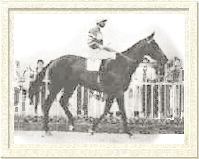
Half Crown, an outstanding runner. Photo courtesy Argentine Thoroughbred Gallery.
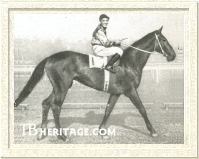
Hamlet
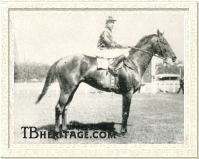
Hamlet's brother, Tatal
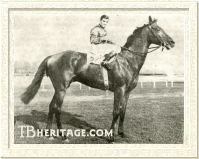
Carnaval
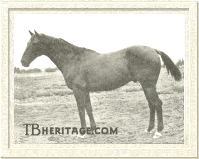
Postin
| | Hunter's Moon's third classicist was the outstanding filly HALF CROWN (f. 1942 out of Meneguina by Leteo). One of the great runners of her era in Argentina, at three, she won the Polla de Potrancas-Argentine 1,000 Guineas, the Gran Premio Jorge Atucha, and Gran Premio 25 de Mayo, from the same foal crop that included Miss Grillo (later also a major stakes winner and producer in the U.S.). The next season, Half Crown was undefeated in five starts, winning the Gran Premio Ignacio y Ignacio Correas, Clasico Pueyrredón (against males), Clasico Juarez Celman, Clasico A.R. Bullrich, and Clasico Gilberto Lerena. As a broodmare, she produced stakes winner Half Empire (by British Empire).
Hunter's Moon's best sons include HAMLET (c. 1942 out of Stop Her by Silurian). He won the clasico Palermo, Ejército de Chile, and Alberto Vial Infante, and ran second to Tábano in the Derby. He became a top sire and excellent broodmare sire. His brother TALTAL (c. 1939), won nine races in Chile, including the Jorge Phillips, Vice-Presidente Henry Wallace, Calixto Ovalle, Pedro del Rio, Cuerpo de Bomberos de Valparaiso, Gran Premio Viña del Mar, and the Internactional de Chile. He was sire of several good runners and sire sons in Chile, including Combatiente, a winner of such races as the Chilean Polla de Potrillos and the Alberto Vial, and Los Copahues, winner of the Viña del Mar, Gran Premio Bernardo O'Higgins, Club Hípico de Santiago, and others.
CARNAVAL (c. 1939 out of Servilia II by Silurian), a good stayer, won demanding distance races in Chile, including the Club Hípico de Santiago, the Internactional, the premio España (3,000 meters), and the Viña del Mar. He was a sire of classic winners in Chile, including Manderley and Norweste.
HOLY SMOKE (c.1938 out of Sin Nicotina by Picacero) won the Argentine Jockey Club Stakes in record time, and was a good sire, his son, Arnedano a classic winner and sire; HALIFAX (c. 1935 out of Corfu by Copyright); a top stayer, and sire in Chile, sire of Picafort.
Hunter's Moon's son POSTIN (c. 1940 out of Quinta by Codihue) won 13 races from 24 starts in Peru including the Clasico Presidente de la Republica (twice), Clasico Jockey Club de Lima, Clasico Independencia, Clasico La Copa; and became a leading sire in his adopted country. He was so influential that in 1955, all six runners of the Derby del Peru were by him, and in 1956 in the Gran Premio del Peru, all seven runners were by him. His most important offspring was the Peruvian champion filly Pamplona II, who later produced Derby Stakes winner Empery and Poule d'Essai des Pouliches-French 1,000 Guineas winner Pampered Miss. He also got Rio Pallangra, whom many considered the best horse ever to run in Peru. Some of his good sire sons included Pertinaz, Pirulin, and Pavelo.
|
Hunter's Moon's top runners also included Brazilian runners HELIUM (c. 1931 out of Claque by Copyright), who won the 1937 Gran Premio Brasil (G1, 3,000 meters) and stood at stud in that country; LORETTA (f. 1945 out of Louisiania by Maron), winner of the 1949 Gran Premio Marciano de Aguiar Moreira (G1); FAIRPLAY (c. 1947 out of Fairy Song by Fairway), 1952 Gran Premio Derby Club (G2); and ACAPULCO (c. 1949 out of Achray by Rhodes Scholar) 1953 Gran Premio Derby Club (G2).
Other good ones by Hunter's Moon include HARICOT (c. 1935 out of Rackarock by Phalaris), HIEDRA (f. 1936 out of Salamandra by Silurian), HOP-ON (f. 1938 Paragrand by Grand Parade), HURONA (f. 1943 out of Contra by Copyright), and HALCONERO (c. 1942 out of Salamandra by Silurian) and North American stakes winner Halconero (c. 1942 out of Salamandra by Silurian).
Breeding true to his Hurry On sireline, Hunter's Moon proved an outstanding sire of stayers. Many of his sons earned him a reputation as a sire of sires, and his many successful daughters also made him a tremendous broodmare sire. In fact, he was the Leading Broodmare Sire in Argentina in 1954. His daughters include
the important broodmares HIMALAYA (f. 1931 out of Paretnope by Perrier; dam of Endeavour II), NINA CHOLE (f. 1938 out of Clothall by Papyrus; dam of Quetzalcoatl, Coya Bruja, Carapunco, and Coatlihue; ancestress of Indian Chief II), HOLDA (f. 1940 out of Contra by Copyright; dam of classic winners Hold Her, Himera), HEAT WAVE (f. 1937 out of Spit Fire by Silurian; second dam of Tronado), and HAVOC (f. 1940 out of Lady Wood by Foxlaw; third dam of Escudo Real).
Hunter's Moon was the perfect example of how frequently a well-bred but only moderately successful runner in England can dramatically upgrade a "colonial" breeding population like those he entered in South America. He is also yet another example of the tremendous global influence his dam, the mighty atom Selene, exerted on the Thoroughbred of the Twentieth Century.
--Anne Peters
|
|
|
|

